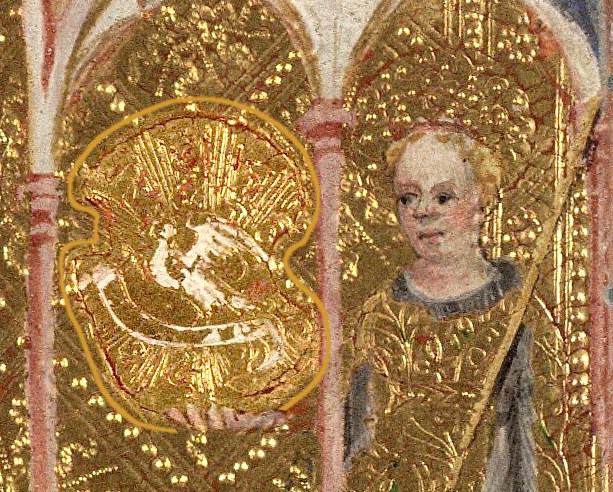Hi, Marco,
Thanks for the Petrarchian allusions.
Phaeded wrote:Its not that the coin-shield has any old Visconti emblem its that it has the emblem that only appears on the coin suits. As Kaplan demonstrated, two of the suits feature Sforza emblems – the swords and batons (fitting for a condottiero) – while the other two suits - cups and coins – feature those of Visconti. That alone signals a “merger” – hence the logical guess that a wedding was the occasion for the cards. So if the context is the CY cards and of the four suits only the coins feature the radiant dove, then there must have been a reason that the Chariot holds this very same symbol.
Yes, it may have been a wedding deck. But there is no coin, and the dowry invention is entirely gratuitous.
As I asked before, why might Chastity be associated with one of the Visconti (the bride's family) emblems, from one of the feminine suits (Cups or Coins)? Why would Chastity's shield bear a device associated with the bride? The answer is, it's like Petrarch being identified with the
Triumph of Love and Laura with the
Triumph of Chastity -- it's conventional.
Phaeded wrote:As for your exclusive focus on chastity: Who concluded the Visconti radiant dove meant “love” and why would “a bon droyt” be scrolled across the dove if “love” were the sentiment being expressed? The dove could just as easily refer to the Holy Ghost (something the Manfreda “Papess” cult was tied to and to which various members of the Visconti family were connected, hence a religious strain connected to their dynasty and “good right” to rule).
Ignoring the nonsense part of your comment, a radiant dove would
inescapably call to mind the Holy Spirit, which is a reasonable conflation for a Chaste Love composition. Meanings which reinforce and elaborate or extrapolate the main meaning are precisely what an audience of that time and place would see, and what an artist of that provenance would intend.
As for "exclusive" focus, there are two main approaches to iconography seen in places like this forum. One approach looks for necessary and sufficient explanation, while the other embraces everything that fertile, often anachronistic imagination can tack on. Why would I exclude a meaning that is false? I belong to the first school of interpretation, and the coin is not necessary (the shield suffices) nor even adequate (it's not a coin), much less sufficient.
Phaeded wrote:Finally, why doesn’t the woman on the chariot wield the shield as such, like your illumination’s Chastity does? Instead she holds it out in front of her, almost as an offering.
She displays it. Period. She does this the same way a thousand other allegorical figures display their identifying attributes, as of to say, "Look at this!"
Phaeded wrote:She is either offering up her chastity to her suitor (making herself defenseless against love), offering the charge of protection to her suitor by way of the shield (Sforza to be Filippo’s captain general),
So, contrary to the centuries of pervasive sensibilities and the obvious symbolism of this subject triumphing over Love, you think that this is a Slut Card? Instead of
A Bon Droyt there should be a banner reading
Do Me Now! Hmmm...
Here is a Triumph of Chastity where the shield is simply resting at her knee. It doesn't mean she is giving up, that Cupid wins. He is already defeated, wings clipped and marching as captive. In the same way,
the order of the cards in Tarot established -- for those who had forgotten Petrarch or were unfamiliar with the conventions of chivalrous love -- that Virtue triumphs over Vice.

It's not that such stories aren't entertaining. It's that they are unnecessary. There doesn't seem to be a legitimate question to be answered by such inventions. Historically, rather than creatively, our question is how to explain the evidence we find. Your theory was wrong -- it is not a coin of any kind, it is a shield. She is holding out the shield, with the Visconti device emblazoned on it. It identifies her as Chastity and associates her with the bride's family.
The radiant dove is a great emblem.
 visconti-sforza-dove-fledglings.jpg
Viewed 13323 times 84.08 KiB
visconti-sforza-dove-fledglings.jpg
Viewed 13323 times 84.08 KiB
As for the other point you made:
Phaeded wrote:The coin-shield had to fit within the posts of the chariot's canopy, unlike the coin suit cards, hence its irregular shape.
So it couldn't be larger or round? Hmmm... the artistic technique you are confused by is termed occlusion, and it was shown repeatedly in this deck... in fact, on this very card. Here's what a large round coin would have looked like, one that did not fit within the posts of the Chariot's chariot. (Pardon the extra fingers growing out of her wrist -- I had to do this quickly.)
Best regards,
Michael
We are either dwarfs standing on the shoulders of giants, or we are just dwarfs.




